At the beginning of December, we took note of the many books remaining on our shelves that we wanted to see reviewed in this weekly column before the end of the year. So here, in the last column of the year, are sixteen of these books published in 2017 that we think are just too good to miss.
Ages 4–8
All the Way to Havana. Margarita Engle. Ill. Mike Curato. 2017. Godwin/Henry Holt.
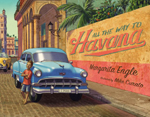 A boy describes a trip in Cara Cara, the family’s dilapidated blue car (a 1954 Chevy), from his village to the bustling capital city of Havana, where they join a parade of colorful old cars. “Many of the cars roar, growl, whine, or putt putt, but most just honk, honk, honk as they glide bumpety bump on potholed city streets.” Author’s and illustrator’s notes provide a context for this story set in Cuba, a country where a family’s loyalty extends to its car.
A boy describes a trip in Cara Cara, the family’s dilapidated blue car (a 1954 Chevy), from his village to the bustling capital city of Havana, where they join a parade of colorful old cars. “Many of the cars roar, growl, whine, or putt putt, but most just honk, honk, honk as they glide bumpety bump on potholed city streets.” Author’s and illustrator’s notes provide a context for this story set in Cuba, a country where a family’s loyalty extends to its car.
—CA
My Dog Mouse. Eva Lindström. Trans. Julia Marshall. 2017. Gecko.
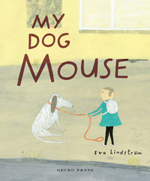 A young girl takes Mouse, an old dog, on a slow and rambling walk to a park. “Step, pause. Step, pause.” Readers will bask in the comfortable friendship of girl and dog expressed by the softly colored illustrations and the leisurely pace of the narrative. Back where they began, the girl watches as Mouse follows his owner inside his home and wistfully says, “I wish Mouse was mine.”
A young girl takes Mouse, an old dog, on a slow and rambling walk to a park. “Step, pause. Step, pause.” Readers will bask in the comfortable friendship of girl and dog expressed by the softly colored illustrations and the leisurely pace of the narrative. Back where they began, the girl watches as Mouse follows his owner inside his home and wistfully says, “I wish Mouse was mine.”
—NB
Once There Was a Story: Tales from Around the World, Perfect for Sharing. Jane Yolen. Ill. Jane Dyer. 2017. Paula Wiseman/Simon & Schuster.
 This collection of 32 tales from around the world, organized in three sections: “Homey Tales,” “The Very Best Beastly Tales,” and “Tales of Magic,” includes both well-known stories such as “The Little Red Hen” (England) and “The Tortoise and the Hare” (Greece/Aesop) and lesser-known ones such as “Plip, Plop” (Tibet) and “Ali’s Wretched Sack” (Iran/a Sufi story). Yolen’s retellings of folktales, fables, and stories, complemented by Dyer’s charming watercolor illustrations, are perfect for reading aloud to young children.
This collection of 32 tales from around the world, organized in three sections: “Homey Tales,” “The Very Best Beastly Tales,” and “Tales of Magic,” includes both well-known stories such as “The Little Red Hen” (England) and “The Tortoise and the Hare” (Greece/Aesop) and lesser-known ones such as “Plip, Plop” (Tibet) and “Ali’s Wretched Sack” (Iran/a Sufi story). Yolen’s retellings of folktales, fables, and stories, complemented by Dyer’s charming watercolor illustrations, are perfect for reading aloud to young children.
—CA
Plume. Isabelle Simler. 2017. Eerdmans.
 An elegant, digitally created portrait of a bird (peacock, blackbird, nuthatch, turkey, and fourteen more) is paired with delicately detailed drawings of one or more of its feathers on each oversize double-page spread. The presence of Plume (the black cat looking at feathers on the cover) is evident throughout the book with a nose, paw, ear, or whiskers along the edge of a page or its body partially hidden behind a bird. Plume’s special interest in feathers is revealed on the final pages.
An elegant, digitally created portrait of a bird (peacock, blackbird, nuthatch, turkey, and fourteen more) is paired with delicately detailed drawings of one or more of its feathers on each oversize double-page spread. The presence of Plume (the black cat looking at feathers on the cover) is evident throughout the book with a nose, paw, ear, or whiskers along the edge of a page or its body partially hidden behind a bird. Plume’s special interest in feathers is revealed on the final pages.
—CA
Small Walt. Elizabeth Verdick. Ill. Marc Rosenthal. 2017. Paula Wiseman/Simon & Schuster.
 Walt, the smallest snowplow, clears the streets with driver Gus during a blizzard although the BIG snowplows doubt his ability to complete the challenging task. Digitally colored drawings featuring a bright red personified Walt and a lively narrative punctuated with chants (“My name is Walt. / I plow and I salt . . .”) and onomatopoeia (“ERRR Vroom-vaRoom!”) make this book a delightful read aloud.
Walt, the smallest snowplow, clears the streets with driver Gus during a blizzard although the BIG snowplows doubt his ability to complete the challenging task. Digitally colored drawings featuring a bright red personified Walt and a lively narrative punctuated with chants (“My name is Walt. / I plow and I salt . . .”) and onomatopoeia (“ERRR Vroom-vaRoom!”) make this book a delightful read aloud.
—NB
Winter Dance. Marion Dane Bauer. Ill. Richard Jones. 2017. Houghton Mifflin Harcourt.
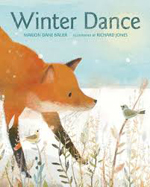 “A single snowflake floats through the air,” and a red fox asks other creatures of the forest what to do. No answer is right for him until he meets another red fox who advises, “. . . that’s what / we fine red foxes / do in winter. / Dance!” A lyrical text and beautifully detailed illustrations with soft textured backgrounds, rendered with wax and pencil crayons, capture the mystery of the season—and the imaginations of readers.
“A single snowflake floats through the air,” and a red fox asks other creatures of the forest what to do. No answer is right for him until he meets another red fox who advises, “. . . that’s what / we fine red foxes / do in winter. / Dance!” A lyrical text and beautifully detailed illustrations with soft textured backgrounds, rendered with wax and pencil crayons, capture the mystery of the season—and the imaginations of readers.
—NB
Ages 9–11
The Player King. Avi. 2017. Atheneum/Simon & Schuster.
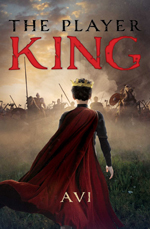 In 1486, orphan Lambert Simnel, kitchen boy at Tackley’s Tavern, is recruited by Friar Simonds to impersonate missing young Prince Edward and reclaim the British throne from the King Henry VII (who killed the prince’s father, King Richard III in combat) to restore the old order. After King Henry defeats Lambert’s army, Lambert, ironically, ends up in the palace kitchen instead of being hanged for treason. He laments, “I am Lambert Simnel, who was, once, very briefly a king. A player king.” An author’s note provides the facts behind this historical novel.
In 1486, orphan Lambert Simnel, kitchen boy at Tackley’s Tavern, is recruited by Friar Simonds to impersonate missing young Prince Edward and reclaim the British throne from the King Henry VII (who killed the prince’s father, King Richard III in combat) to restore the old order. After King Henry defeats Lambert’s army, Lambert, ironically, ends up in the palace kitchen instead of being hanged for treason. He laments, “I am Lambert Simnel, who was, once, very briefly a king. A player king.” An author’s note provides the facts behind this historical novel.
—NB
Tumble & Blue. Cassie Beasley. 2017. Penguin/Random House.
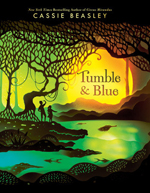 Two hundred years ago, two ancestors of Blue Montgomery and Tumble Wilson talked Munch, a magical Okefenokee Swamp golden alligator, into splitting between them his offer to change one person’s fate on the night of a red sickle moon. Since that time, the fates of their descendants are either blessings or curses. After they meet and become friends in Murky Branch, Georgia, Blue, whose fate is to always lose, and Tumble, whose attempts at superheroism always end disastrously, journey into the swamp on the night of the red moon to change their destinies.
Two hundred years ago, two ancestors of Blue Montgomery and Tumble Wilson talked Munch, a magical Okefenokee Swamp golden alligator, into splitting between them his offer to change one person’s fate on the night of a red sickle moon. Since that time, the fates of their descendants are either blessings or curses. After they meet and become friends in Murky Branch, Georgia, Blue, whose fate is to always lose, and Tumble, whose attempts at superheroism always end disastrously, journey into the swamp on the night of the red moon to change their destinies.
—CA
The Wonderling. Mira Bartók. 2017. Candlewick.
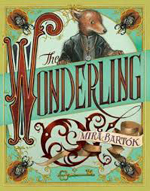 Shy, 11-year-old, one-eared groundling Number Thirteen is part fox, part child. He is captive at the nefarious Miss Carbunkle’s Home for Wayward and Misbegotten Creatures, where music is forbidden, with only remnants of a lullaby as his earliest memory. A reluctant hero, he befriends Trinket, a bird groundling, who renames him Arthur and arranges a dramatic escape to find their families—and for Arthur to seek his destiny and finally “find” his voice. Middle graders will enjoy this high-adventure Victorian steampunk animal fantasy with music, clever prose, and quaint illustrations, done in ink, graphite, and gouache.
Shy, 11-year-old, one-eared groundling Number Thirteen is part fox, part child. He is captive at the nefarious Miss Carbunkle’s Home for Wayward and Misbegotten Creatures, where music is forbidden, with only remnants of a lullaby as his earliest memory. A reluctant hero, he befriends Trinket, a bird groundling, who renames him Arthur and arranges a dramatic escape to find their families—and for Arthur to seek his destiny and finally “find” his voice. Middle graders will enjoy this high-adventure Victorian steampunk animal fantasy with music, clever prose, and quaint illustrations, done in ink, graphite, and gouache.
—NB
Writing Radar: Using Your Journal to Snoop Out and Craft Great Stories. Jack Gantos. 2017. Farrar, Straus and Giroux.
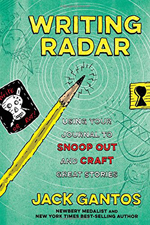 In his characteristic witty style, master storyteller Jack Gantos offers a wealth of practical advice on writing stories. He emphasizes the importance of reading good books to turn on the “powerful Writing Radar story-finding talent within you.” Gantos peppers his kid-friendly guide to journaling with examples of his own childhood experiences as a writer and humorous pen-and-ink drawings. He includes three “Writing Connections” exercises to get young writers started on storytelling with confidence.
In his characteristic witty style, master storyteller Jack Gantos offers a wealth of practical advice on writing stories. He emphasizes the importance of reading good books to turn on the “powerful Writing Radar story-finding talent within you.” Gantos peppers his kid-friendly guide to journaling with examples of his own childhood experiences as a writer and humorous pen-and-ink drawings. He includes three “Writing Connections” exercises to get young writers started on storytelling with confidence.
—CA
Ages 12–14
Bound by Ice: A True North Pole Survival Story. Sandra Neil Wallace & Rich Wallace. 2017. Calkins Creek/Highlights.
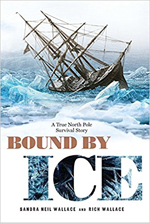 On July 8, 1879, the USS Jeannette set out from San Francisco on an expedition to the North Pole. After being ice bound and drifting for almost two years, the vessel was freed from the ice only to sink after being trapped again. “Thirty-three men embarked on the Jeannette’s Arctic journey to reach the North Pole. Twelve survived.” The engrossing narrative account of the ill-fated voyage includes letters, journal entries, letters, archival photos, and illustrations.
On July 8, 1879, the USS Jeannette set out from San Francisco on an expedition to the North Pole. After being ice bound and drifting for almost two years, the vessel was freed from the ice only to sink after being trapped again. “Thirty-three men embarked on the Jeannette’s Arctic journey to reach the North Pole. Twelve survived.” The engrossing narrative account of the ill-fated voyage includes letters, journal entries, letters, archival photos, and illustrations.
—CA
The Stars Beneath Our Feet. David Barclay Moore. 2017. Alfred A. Knopf/Random House.
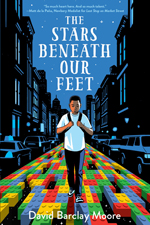 In 12-year-old Trinidadian Lolly Rachpaul’s journey of self-discovery, he is still reeling over the recent gang-related Harlem murder of his brother, Jermaine. Guided by Ali, an after-school program social worker, Lolly escapes harsh reality by constructing a kingdom with Lego blocks and creating an imaginative story about its inhabitants in a vacant room in the Community Center. After autistic Rose butts her way in, snapping her own buildings together with his Legos, Lolly’s challenge to her, a Ten-Foot Tower Contest, leads to unexpected life lessons.
In 12-year-old Trinidadian Lolly Rachpaul’s journey of self-discovery, he is still reeling over the recent gang-related Harlem murder of his brother, Jermaine. Guided by Ali, an after-school program social worker, Lolly escapes harsh reality by constructing a kingdom with Lego blocks and creating an imaginative story about its inhabitants in a vacant room in the Community Center. After autistic Rose butts her way in, snapping her own buildings together with his Legos, Lolly’s challenge to her, a Ten-Foot Tower Contest, leads to unexpected life lessons.
—NB
You Bring the Distant Near. Mitali Perkins. 2017. Farrar Straus Giroux.
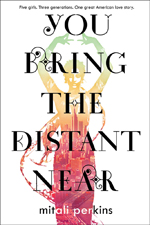 Beginning with the immigration in 1973 of Tara and Sonia Das with their parents to New York City (via Ghana and London), Perkins explores the experiences of three generations of Das women through the alternating teen voices of first Tara and Sonia and then their daughters, Anna and Chantal. This is a warm and thought-provoking story of searching for identity and the balancing of cultural expectations as well as a story of strong women finding love and the blending of cultures.
Beginning with the immigration in 1973 of Tara and Sonia Das with their parents to New York City (via Ghana and London), Perkins explores the experiences of three generations of Das women through the alternating teen voices of first Tara and Sonia and then their daughters, Anna and Chantal. This is a warm and thought-provoking story of searching for identity and the balancing of cultural expectations as well as a story of strong women finding love and the blending of cultures.
—CA
Ages 15+
Disappeared. Francisco X. Stork. 2107. Arthur A. Levine/Scholastic.
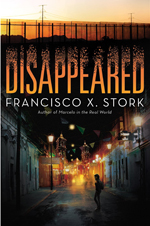 After Sara Zapata, a journalist in Juárez, Mexico, uncovers evidence tying the head of the State Police to missing local women (including her best friend, Linda Fuentes), she receives an anonymous death threat. Sara’s entrepreneurial brother, Emiliano, has just received a job offer that involves smuggling drugs in piñatas that is lucrative and promises to curry favor with the father of Perla Rubi, his wealthy out-of-reach love. Sara’s and Emiliano’s stories intersect in a race for survival.
After Sara Zapata, a journalist in Juárez, Mexico, uncovers evidence tying the head of the State Police to missing local women (including her best friend, Linda Fuentes), she receives an anonymous death threat. Sara’s entrepreneurial brother, Emiliano, has just received a job offer that involves smuggling drugs in piñatas that is lucrative and promises to curry favor with the father of Perla Rubi, his wealthy out-of-reach love. Sara’s and Emiliano’s stories intersect in a race for survival.
—NB
The 57 Bus: A True Story of Two Teenagers and the Crime That Changed Their Lives. Dashka Slater. 2017. Farrar Straus Giroux.
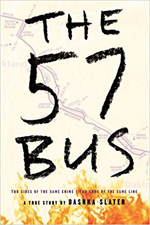 In Oakland, California, on November 4, 2013, the homeward journeys of two teens on the 57 bus overlap for just eight minutes, a brief period of time in which both their lives are changed. Sasha is sixteen, white, identifies as agender, lives in middle-class Oakland Hills, and attends a small private high school. Richard is sixteen, African-American, lives in East Oakland’s flatlands, and is a junior at Oakland High School. As the bus moves along, Sasha has been reading Anna Karenina;Richard has been goofing around with his companions. Sasha falls asleep, and Richard flicks a lighter, and the flame touches the hem of Sasha’s gauzy white skirt. In short chapters, Slater tells the before and after stories of Sasha and Richard and explores issues of race, class, gender, and problems of the criminal justice system and juvenile incarceration.
In Oakland, California, on November 4, 2013, the homeward journeys of two teens on the 57 bus overlap for just eight minutes, a brief period of time in which both their lives are changed. Sasha is sixteen, white, identifies as agender, lives in middle-class Oakland Hills, and attends a small private high school. Richard is sixteen, African-American, lives in East Oakland’s flatlands, and is a junior at Oakland High School. As the bus moves along, Sasha has been reading Anna Karenina;Richard has been goofing around with his companions. Sasha falls asleep, and Richard flicks a lighter, and the flame touches the hem of Sasha’s gauzy white skirt. In short chapters, Slater tells the before and after stories of Sasha and Richard and explores issues of race, class, gender, and problems of the criminal justice system and juvenile incarceration.
—CA
Genuine Fraud. E. Lockhart. 2017. Delacorte/Random House.
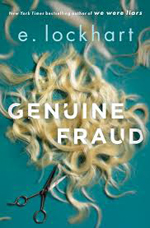 These things are true about Julietta (“Jule”) West Williams: She’s a liar, survivor, fighter, and chameleon who finally has a best friend, Imogen. Beginning during the third week of June 2017, in Cabo San Lucas, Mexico, and moving steadily backward in time to the first week of June 2016, in New York City, this thriller lands back in the opening scene for a double-plot twist grand finale that readers won’t see coming.
These things are true about Julietta (“Jule”) West Williams: She’s a liar, survivor, fighter, and chameleon who finally has a best friend, Imogen. Beginning during the third week of June 2017, in Cabo San Lucas, Mexico, and moving steadily backward in time to the first week of June 2016, in New York City, this thriller lands back in the opening scene for a double-plot twist grand finale that readers won’t see coming.
—NB
Nancy Brashear is Professor Emeritus of English from Azusa Pacific University, in Azusa, California. Carolyn Angus is former Director of the George G. Stone Center for Children's Books, Claremont Graduate University, in Claremont, California.
These reviews are submitted by members of the International Literacy Association's Children's Literature and Reading Special Interest Group (CL/R SIG) and are published weekly on Literacy Daily.